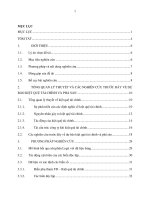SKKN Dạy Từ Vựng Thông Qua Sự Kết Hợp Giữa Các Từ
Bạn đang xem bản rút gọn của tài liệu. Xem và tải ngay bản đầy đủ của tài liệu tại đây (172.48 KB, 14 trang )
SangKienKinhNghiem.org
Tổng Hợp Hơn 1000 Sáng Kiến Kinh Nghiệm Chuẩn
SỞ GIÁO DỤC VÀ ĐÀO TẠO ĐỒNG NAI
Đơn vị TRƯỜNG TRUNG HỌC PHỔ THÔNG TRẤN BIÊN
Mã số: ................................
SÁNG KIẾN KINH NGHIỆM
DẠY TỪ VỰNG THÔNG QUA SỰ KẾT HỢP
GIỮA CÁC TỪ
Người thực hiện: VŨ NGUYỄN MINH NGỌC
Lĩnh vực nghiên cứu:
Quản lý giáo dục
Phương pháp dạy học bộ môn: Anh văn
Phương pháp giáo dục
Lĩnh vực khác:
Có đính kèm:
Mô hình
Phần mềm Phim ảnh
Hiện vật khác
SƠ LƯỢC
LÝ LỊCH KHOA HỌC
Năm học: 2011 - 2012
1
Vu Nguyen Minh Ngoc
Teaching Vocabulary through Collocations
2
SƠ LƯỢC LÝ LỊCH KHOA HỌC
I. THÔNG TIN CHUNG VỀ CÁ NHÂN
1. Họ và tên: VŨ NGUYỄN MINH NGỌC
2. Ngày tháng năm sinh: 29- 12-1975
3. Nam, nữ: Nữ
4. Địa chỉ: 506 A2 Chung Cư Nguyễn Văn Trỗi - Quang Vinh – Biên Hòa
5. Điện thoại: 061.3826698
6. Fax:
(CQ)/
(NR); ĐTDĐ:
E-mail:
7. Chức vụ: Giáo viên
8. Đơn vị công tác: Trường THPT Trấn Biên
II. TRÌNH ĐỘ ĐÀO TẠO
- Học vị (hoặc trình độ chuyên môn, nghiệp vụ) cao nhất: cử nhân Anh văn
- Năm nhận bằng: 1998
- Chuyên ngành đào tạo: Sư phạm khoa Anh văn
III.KINH NGHIỆM KHOA HỌC
- Lĩnh vực chuyên môn có kinh nghiệm: môn Tiếng Anh
- Số năm có kinh nghiệm: 12
- Các sáng kiến kinh nghiệm đã có trong 5 năm gần đây:
Vu Nguyen Minh Ngoc
Teaching Vocabulary through Collocations
2
INTRODUCTION
Nowadays English has become important and necessary to study. A lot of
Vietnamese people use it as a tool to communicate at work, on business and in many
fields. Many new methods have been applied to teach English. Although it is a
compulsory subject most of the students don’t study well. One of the main causes is
their incomplete awareness of the purpose of learning English.Many teachers have been
teaching words in isolation with synonyms, antonyms or word family and give
Vietnamese equivalents without providing students with any other contexts. Vocabulary
is essential element in conveying information is taught and learned cursorily. In order
to master a language we have to understand and speak it fluently, but we don’t know
how to use new words. Therefore, motivating students to learn English is necessary I
think there are a lot of wayso vocabulary as. Teaching vocabulary is one of the ways to
help them learn better. However, there are a lot of ways to teach vocabulary such as:
root; prefix and suffix; synonyms and antonyms; phrasal verbs; collocation; pictures,
flashcards, objects...etc. In my opinion, teaching vocabulary collocation is one of the
important ways to help stusents to study well because the students tend to learn
vocabulary with word by word and understand the meaning of each word. They don’t
know that it is impossible to read a text as a whole in this way. As a result, they often
have trouble in reading. For this reason, I would like introduce teaching vocabulary
collocation to my students.
Vu Nguyen Minh Ngoc
Teaching Vocabulary through Collocations
CONTENT
What is collocation?
Collocations are combinations of words which are used together. If we want to use a
word naturally, we need to learn the other words that often go with it. This can be
different from language to language. For example, in English we say:
I missed the bus.(= I didn’t catch the bus) ( NOT I lost the bus)
He had to go to hospital; it’s a serious injury. (= a bad injury) ( NOT a grave injury)
There are a few ways collocations are used in.
Verb + Noun
The meaning of many of these examples may be clear, but did you know these verbs
and nouns go together? Are they the same or different in your language?
start
a car
(= turn on the engine)
a family (= think about having a first child)
tell
a story
a joke (= a funny story)
miss
a person (= be happy because a particular person is not there)
a lesson (= not go to a lesson)
get on a bus (opp get off a bus)
waste time / money (= use it badly)
2
Vu Nguyen Minh Ngoc
Teaching Vocabulary through Collocations
Adjective + Noun
a soft
drink (= non-alcoholic drink)
voice ( opp a loud voice)
wine (opp sweet wine)
dry
weather (opp wet weather)
rain (= raining a lot)
heavy
traffic (= a lot of cars on the road)
smoker (= a person who smokes a lot)
a great
success (= very successful)
time ( = an enjoyable time)
hard work (= difficult physically or mentally)
a hard question ( = difficult to answer)
Examples:
The conference hard work but every said it was a great success.
Threre was heavy traffic in the city center because of the wet weather.
We had a great time in Brazil – the beaches are fantastic.
Adverb + Adjective
The underlined adverbs in 1-3 mean “very”, the adverbs in 4-5 mean “fully/
completely”. In each case, we often use these adverbs with the adjectives that follow
them. Notice also the phrases in bold.
1. I’m terribly sorry to bother you. (= to disturb you), but is Steven there?
2. She is well aware of the problem. (= she knows all about the problem)
3. It is vitally important to make a note of common collocations in your notebook.
3
Vu Nguyen Minh Ngoc
Teaching Vocabulary through Collocations
4. He’s fast asleep. (= in a deep sleep)
She was wide awake (= fully awake) a minute ago.
Noun + Noun
package holiday
Verb + Adjective + Noun
have a great time
Verb + Adverb
discuss calmly
Verb + Preposition + Noun
hand in an assignment
How can I help my students with collocations?
I argue that students at every level need to be aware of the importance of
collocation. I believe that collocation can be used not only to help learners understand
and manage lexis but also to communicate ideas more effectively.
For example, there is the difference in meaning between “glance” and “glimpse”.
After some contexts in which these words might be used, we produced the following :
glance
She glanced at her
watch.
Glimpse
I only had time to
glance
at
the
newspapers.
He had glimlsed her
through the window
as he passed.
I glimpsed a car as
it drove past
4
Vu Nguyen Minh Ngoc
Teaching Vocabulary through Collocations
It was clear to me how helpful it was to use collocation to highlight the differences
between the two verbs. I have also found collocation useful in explaining the difference
between opposites:
light green / dark green
light suitcase / heavy suitcase
You can give you alternative ways of saying something, which may be more colourful
or more precise. For example, instead of repeating it was very cold and very dark, we
can say it was bitterly cold and pitch dark.Collocations can improve your style in
writing: instead of saying poverty causes crime, you can say poverty breeds crime;
instead of saying big meal you can say a substantial meal.
H.Long and C.Richards (2001) mentioned that another advantage of learning
collocations is to help the learners express themselves more fluently than learning
individual words. When learners memorize vocabulary as chunks instead of isolated
words, they can produce language faster and more fluently because they don’t need to
think about the individual words but they can produce the chunks as an item. For
example, learners will speak “ Please close the window”; “ Can I have the bill, please?”;
“ Pleased to meet you.” faster and more fluently when learn the whole chunk than
learning the individual words as close, window, please.
Lewis (2000) states that knowing a word includes knowing its collocations. It
means that, in any collocations, one word will “call up” another word in the mind of the
native speakers. In other words, the learners can predict the other word when they hear
one word with the various degrees of success. That helps the learners understand more
deeply what the native speakers spoke and be more understood by the native speakers.
Types of Collocation
1. De-lexicalised Verbs
De-lexicalised verbs (get, have, make, do, put, take) are important when teaching
collocation although they may have a basic meaning (make = create/manufacture,
have = own/possess), they are more commonly used in combinations with nouns or
other words as a chunk of meaning:
Examples:
make a mistake
do your homework
5
Vu Nguyen Minh Ngoc
Teaching Vocabulary through Collocations
take an exam
In my experience, a lot of mistakes in collocations are made with de-lexicalised verbs,
probably due to leanrer language interference .
2. Nouns
I think that it is very useful to teach learners these collocations with a noun as a
key word because the majority of general nouns usually require further
qualification:
Examples:
Good / well-paid / menial / boring / full-time job
Package / luxury / expensive / cheap / good
Nouns are also important because they are usually the words that carry the most
meaning within a sentence.
Strong/ Weak and Frequent/ Infrequent Collocations
There is also a difference between strong/weak and frequent/infrequent
collocations. A collocation that is frequent (e.g. a warm day) is not necessarily
strong, as either word in the partnership suggests a number of other collocates:
sweater
Bad
blanket
wedding
(a)
smile
warm
(a)
Sunny
hug
Rainy
breeze
glorious
day
In the same way, a particularly strong collocation may be used very infrequently (e.g.
bat your eyelashes). The most useful combination for teaching purposes, then, seems to
be a combination of strong (but not completely fixed) and frequent.
A strong/infrequent collocation may be worth mentioning to draw the learners’
attention to its existence, but little, if any, class time would need to be spent on
collocations at the weak/infrequent end of the spectrum.
6
Vu Nguyen Minh Ngoc
Teaching Vocabulary through Collocations
Nation also makes the point that, in a classroom situation, frequent collocations only
deserve attention if: “their frequency is equal to or higher than other high-frequency
words.” This puts a greater pressure on the teacher when making the decision about
whether to spend time on a particular collocation. I feel that if there are enough
potential frequent collocations of one of the nodes, it is worth spending some class time
on:
take a
put (yourself) at run the
Risk
With the second two verbs in this example, the unpredictability of the combination is
also a factor. Most learners at intermediate level or above would be familiar with all
three of the verbs, but few would realise that it is possible to collocate ‘run’ and ‘risk’.
Moreover, this would be a difficult collocation for learners to work out just by knowing
the meaning of the individual parts, so would therefore merit some class time.
What problems do learners have with collocation, and how can we help?
1.Quantity/Arbitrariness
A major stumbling block to most learners is the fact that there are so many possible
collocations and that the choice of which word to collocate with, say, a noun is
completely arbitrary. This leads to the question: “Well, why is it have a coffee not drink
a coffee?” and the inevitable reply (hated by teachers and students alike): “It just is.”
If students are encouraged to record collocations as they occur, they have a
permanent record of which combinations are possible. Class time can be given for
learners to revise and practise the collocations they have learnt (see below for
suggestions) or to add new ones.
There are various ways for learners to record new collocations in their vocabulary notebooks. I have
found that the most effective is to use a box format such as:
(verb)
(adjective)
(verb)
(adjective)
(verb)
(adjective)
noun
For lower level learners it might be helpful to organise their collocation boxes by
topic (in the same order as their coursebooks) – jobs, family, food etc. Intermediate
learners may prefer to organise by keyword – work, holiday etc – and advanced
students by grammatical structure – verb + noun; noun + adjective etc. Organisation is
7
Vu Nguyen Minh Ngoc
Teaching Vocabulary through Collocations
really a matter for individual learners, though, as it should be done according to
personal preference to minimise the learning burden. Learners can leave some entries
in the boxes blank to be completed at a later date with other collocations that they have
noticed independently.
2.Learner Language Transfer
Many learners expect that because they collocate something a particular way in L1, it
will translate directly (and correctly) into English. A quick survey of my current
learners produced the following verb + noun collocations:
English
take the car
have a coffee
L1 Equivalent
Đón xe (Vietnamese)
Literal Translation
Car went
Uống cafe (Vietnamese)
Go by car
Take a coffee
Drink a coffee
do your homework Làm bài tập (Vietnamese) Write your homework
pay attention to
Chú ý (Vietnamese)
Be attentive
Give attention to
go on holiday
Đi nghỉ hè (Vietnamese)
Do attention to
Holiday doing
Do holiday
Leave on holiday
I think that because of this untranslatable teachers should focus on collocations which
can not be translated directly, pointing out contrasts to students instead of similarities.
If learners fail to use a correct collocation, even if their utterance is grammatically
and contextually correct, their English will still sound unnatural and ‘foreign’, to the
8
Vu Nguyen Minh Ngoc
Teaching Vocabulary through Collocations
extent that their addressee may not understand them at all. Compare the following (from
a selection of my learners’ written work):
He survived very strongly.
We own a shopping centre.
I took a good decision.
He knows what he’s speaking about.
I can’t see any problem why.
If we substitute the asterisked words for miraculously, have, made, talking and
reason, these utterances become more natural and nativelike.
Collocation grids can be useful in helping learners to understand which words are
possible collocates and which aren’t, by simply ticking the correct combination.
These grids can be made from the students’ own written (or spoken) work as a correction exercise as
well as more general ones in textbooks:
a person
a bank
money a car
a shop
a wallet
rob
steal
Such grids are also very useful for showing the difference in meaning or use between
two or three words that appear almost the same. The grid may then be used to contrast
with the learner language possibilities for collocation.
3.Meaning and Noticing
Especially when dealing with text, many learners (especially those at lower levels)
tend to focus on individual words that they don’t know, rather than on the collocation.
This is because the usual way of noticing and recording vocabulary is to write the word
(out of context and without its collocates) in a vocabulary notebook with it’s the learner
language translation. Alternatively, more advanced learners will say, “I know that word”
and move on without checking for any collocates in the text. Both of these problems
arise from poor learner-training: learners need to have collocations pointed out to them
before they can be expected to notice them for themselves.
Tải tài liệu bản đầy đủ tại: />9
Vu Nguyen Minh Ngoc
Teaching Vocabulary through Collocations
Tải tài liệu bản đầy đủ tại: />
Tải tài liệu bản đầy đủ tại: />------------------------------------------------------
Tổng Hợp Đề Tài Sáng Kiến Kinh Nghiệm Sư Phạm>>
/>
10









